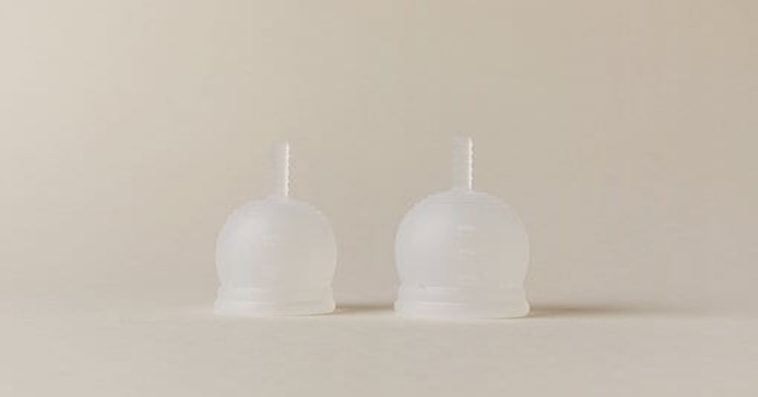A menstrual cup is worth a try for women who want to live with less waste.
There’s nothing more annoying than that one unwelcome visitor who regularly visits once a month (for some girls). For some reason, we can even sense her if she is already near because we experience mood swings and discomfort in random parts of our bodies. For some, acne and pimples began to appear as a warning signal that she is coming! Bloated tummies, monster-like attitude, name it. Girls usually transform into Hulk when it’s “that” time of the month. This scenario is so stressful, and many female individuals can really relate to this.
Since this situation can’t be avoided, we just let out a sigh and prepare the things we need. We stack how many packs of tampons and sanitary pads, and napkins in our cabinets. Hot compress and pain reliever medicines are ready. But, despite the preparedness, it is really a headache when we witness a patch of bloodstain in our sheets. The worst-case scenario is when you knew you have your period from other people, especially from strangers.
Impact of A Period

During these days, the conventional way of dealing with a girl’s periods is through tampons and sanitary pads, and napkins. In the United States alone, the statistics show that 34.1 million women use tampons in 2020. This is a really huge number; include counting how many tampons they need to use within a day. For sanitary pads and napkins usage, it was also estimated that 57.43 million women consumed these products in the same year. Another data also shows that roughly 12 billion pads and 7 billion tampons are discarded each year in just one country. These kinds of stuff are disposable summing up these figures help us paint the picture of what our landfill looks like.
It’s not also absolute that 100% of these end up in landfills. Some also end up clogging gutters, and others even pollute our bodies of water. Just like any other trashes that take a couple of years to break down, tampon applicators on tampons take over 20 years to decompose and poses a threat to the aquatic kingdom as these can be swallowed by marine animals triggering health complications or even death.
Aside from this dilemma, the significant environmental damage these products contribute can be investigated during the processing of raw materials used in their production. The fossil fuel emission during the plastic products used in these products harms the environment the most. The entire cycle of producing these kinds of stuff is an energy-intensive process, specifically due to the low-density polyethylene plastics used in pads and tampon applicators. In short, from the beginning until the end, the entire procedure is so wasteful.
With this, what should be the best alternative? Try a Menstrual Cup.
What Is A Menstrual Cup?
At this moment, you may be familiar with menstrual cups. From social media to blogs, many advertise this product as the best alternative to tampons and sanitary pads, and napkins due to its environmental benefits. Not only it reduces the waste that ends up in our landfills and bodies of water, but switching to menstrual cups also cuts down period costs that are beneficial to consumers.

But before anything else, what is this menstrual cup really? Menstrual cups are bell-shaped cups made of silicone or rubber. As you fold this and insert it into your vagina, it pops open and automatically forms a leakage-proof seal against the vagina, easing your worries about having a bloodstain.
These period cups are said to be already existing in the 1860s. However, they are not promoted until the 1930s, when the famous American actress and singer Leona Chalmers started promoting her patent “catamenial receptor,” or “menstrual cup.” This is because many have expressed their doubts and discomforts about using the early rubber cups. Unlike today, the enhanced design and soft silicone feature sway many consumers, persuading many to switch to using menstrual cups.
Why Use Menstrual Cups?
We already talked about the environmental benefits of using menstrual cups in general. It significantly reduces the number of waste products that pollute the environment. At the moment, we will tackle the other advantages of using menstrual cups, aside from being environmentally friendly.
Saves money.
Since many menstrual cups are designed to be reusable and used in the long term (months and some even years), this cuts down costs, thus providing greater savings to the consumers, which is very relevant today since our necessities are getting expensive. Doing calculations, one reusable menstrual cup is equivalent to how many tampons and/or sanitary pads and napkins already. This is such a saver. Take note that there are also some disposable menstrual cups, so make sure you purchased the sustainable one to save more.
Saves time and effort.
Aside from saving money, switching to sustainable and reusable menstrual cups also save your time and effort in doing your groceries and/or visiting drugstores. You would also not worry anymore in the middle of the night if you’re out of tampons and sanitary pads. Just open your cabinet and get your ready-to-use period cups. It also cuts down carbon emissions during your transportations, which is very helpful in addressing climate change.
No more unpleasant odor
Awful odors caused by fluids exposed to air using tampons and sanitary napkins are unavoidable, and it is embarrassing. By using a menstrual cup, you don’t need to be anxious like that anymore since menstrual cups are designed to prevent any leakages, no possible exposure, no odor at all!
These menstrual cups also help in maintaining the vaginal pH and the good bacteria in place. Compared to tampons and those sanitary pads and napkins that absorb not only your period blood but also your vaginal fluid, which disrupts the vagina’s delicate pH and bacterial balance.
Changer “fewer times” in a day
Unlike tampons and menstrual pads that require to be changed every four to eight hours, depending on your blood flow. Menstrual cups can help you survive without changing up to 12 hours. And if you need to empty it, throw the period blood in the sink or toilet, and viola! All done without adding any trash in the trash can.
Offers you comfort.
Many users shared that menstrual cup is way more comfortable than tampons and pads as they tend not to dry the vagina (vaginal dryness), which is a prevalent complaint in using tampons. Some anecdotal reports also said that menstrual cup users experience fewer and less painful menstrual cramps. But others also insisted it is not.
If you’re still not confident in switching to a menstrual cup, weigh out its pros!
How To Use Menstrual Cup
Enough with the reasons why you should use menstrual cups. For now, here are easy-to-follow steps on how to use a menstrual cup.
Step One: Inserting the menstrual cup.
Wash
- Always remember to wash your hands with clean water and soap before the process.
Fold
- Fold the menstrual cup accordingly to the fold that suits for you. Some of the most common folds are the a. The Punch-Down Fold and the b. C-Fold.
- Be sure to keep folded the period cup folded until it is inside your vagina.
Relax
- Make sure your muscles are relaxed when you insert the menstrual cup. Find a comfortable position. Try squatting, laying down, standing up, or sit on the toilet. After several trials, you’ll eventually find the best position that truly works best for you. You may also opt to use lubricants (water or water-based lubricants) for easier insertion.
Insert and Release.
- Once the folded menstrual cup is already inside and correctly inserted, remove your fingers to let it open up, and you may hear a “pop” or a suction sound. It means the cup was unfolded and the suction sound means everything is already in place and sealed.
- If you’re unsure, you may also reach in again and feel the base of the cup. If it feels round or oval, and you noticed there are no folds, then you are good to go!
Rotate
- On the other hand, if you feel any folds or dents while reaching the base of the menstrual cup, and you’re unsure if it was suctioned and sealed correctly, gently grip the base of the cup and rotate slightly to unfold it.
- If you think your period cup is already placed correctly, try pulling its stem a little bit, if you feel there’s a resistance, it means the cup is in proper place and a suction seal has successfully created.
- Unlike tampons, menstrual cups should be situated lower in the vaginal canal and the stem is placed completely inside.
- Since all bodies are biologically different, and you’re not comfortable with the stem poking out, you can trim it before inserting.
Step Two: Wearing the Menstrual
- Depending on your blood flow, you can use the menstrual cup without changing for up to 12 hours. The menstrual cup can collect more liquid than 3 tampons. Now, you can spend your day doing your activities without frequent checking to your pants!
Step Three: Removing the Menstrual Cup
Wash
- Same as before the inserting process, make sure to clean your hands with clean water and mild soap.
Relax
- Find the position that you are most comfortable with. Lie down, sit on the toilet, squat, or stand up. Just make sure your muscles are relaxed all throughout. You may find it difficult to remove the cup if you have tensed muscles.
Remove
- Remove your menstrual cup by pulling slightly on the stem until you can reach the stem. Gently pinch the base of the cup or insert your index finger alongside it to release the suction seal and ease it out.
- Avoid pulling the stem of the menstrual cup when you are removing as this might cause you discomfort.
Empty and Wash
- After removing the menstrual cup, discard the collected blood flow into the toilet or sink. Clean the cup by rinsing it with water and re-insert.
Re-insert or store
- If your period is over. It’s time to store the menstrual cup correctly. Let the menstrual cup sit in a boiling water for 3-5 minutes and store it into a clean bag or container.
The Downside of Menstrual Cups
After tackling the menstrual cups’ advantages, it would also be biased to expose its pitfalls. Like all other working things on the planet (possessed both and good qualities), the following are common issues in using these “greener” period care products. Take the list as a “beforehand warning” to help you become an expert in using menstrual cups.
- It can be messy.
This is the primary complaint of some menstrual cup users. Emptying the cup can be very messy work. They said that it requires a lot of practice to perfect the skill of neatly emptying it. Cleaning and disposing of the blood flow in some public bathrooms is also a challenge for some.
- You may find it difficult to insert.
Despite this trend going mainstream at present, many women are also still anxious and scared about inserting this foreign thing inside their vaginas. Especially younger girls and those who have never experienced intercourse, inserting these menstrual cups can be a struggle for them. Also, this can be a problem for women with IUDs because they might pull the IUD strings and dislodge them.
- Fitting Problems
Since bodies are anatomically different, proper use of the cup can be a challenge. A menstrual cup may not fit properly. To assure comfort after insertion, ask assistance from your provider to help you out throughout the process.
- You may also find it difficult to remove.
You should master what the most suitable way for you to take out the menstrual cups is. Always remember not to pull the stem. The proper way is to pinch the base and pull the cup, then discard the fluid immediately. Rinse it well and reinsert, just like how it was discussed above.
- Regular Sterilization is a must.
When your period is over, sterilize the cup as tackle above.
The presented shortcomings are just shallows. The advantages of using menstrual cups still outweigh their cons. Set aside your doubts and be brave in exploring how to use this greener alternative during your monthly period. You don’t know how it works if you wouldn’t give it a try, so be hesitant no more! Light research wouldn’t hurt. You can also ask for some advice from the experts and professionals.
Conclusion
Numerous environmental problems are undeniably rampant today. We are running out of time to save this planet, so we need to take care of it in various ways. This dilemma should be addressed globally since people live globally worldwide, and we are the leading cause of why the planet continues to deteriorate. It starts with us. If one would start the initiative, it would eventually lead to a ripple effect of change.
In summary, the sustainability and the environmental benefits of switching to a menstrual cup are very evident. Reiterating reduces the amount of waste production, thus also decreasing the pollutants in our environment. Given that many percent of the population uses disposable tampons and sanitary pads every year, this is a significant movement. Nature has been giving its best to help us survive, not its out turn to give back. Boycott disposable tampons and pads. Let’s choose sustainable menstrual cups.




